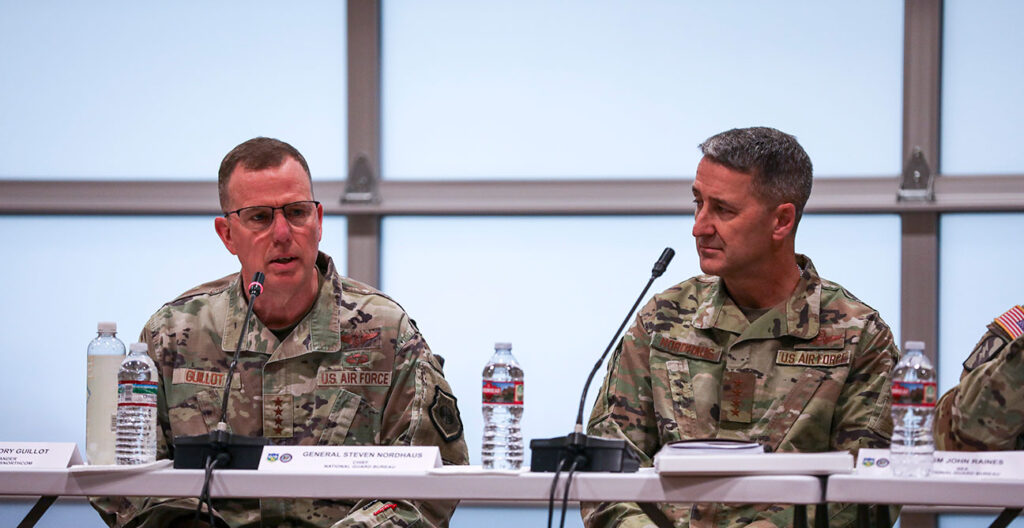Gen. Gregory Guillot, commander of the North American Aerospace Defense Command and U.S. Northern Command, speaks at the National Guard Adjutants General conference at the Colorado National Guard’s 168th Regional Training Site at Fort Carson, Colorado, on October 29, 2024. At right is Air Force Gen. Steven Nordhaus, chief of the National Guard Bureau. SGT. 1ST CLASS ZACH SHEELY/U.S. ARMY NATIONAL GUARD
The National Guard is an essential contributor to North American Aerospace Defense Command and U.S. Northern Command, Gen. Gregory Guillot told a gathering of National Guard leaders at Fort Carson, Colorado, on October 29, 2024. “The success of NORAD/USNORTHCOM starts and stops with the National Guard,” he said.
“We are reliant on the National Guard in all facets of our missions to defend our homeland, conduct security cooperation activities with allies and partners, and support civil authorities,” Guillot, commander of NORAD and USNORTHCOM, told the group of National Guard adjutants general and senior enlisted leaders from the 50 states, three U.S. territories and the District of Columbia. “Like you in your states, we’re not singularly focused. But everywhere I go, I see seamless integration with the reserve component. That will always be the secret sauce we have that our adversaries don’t.”
NORAD is a binational U.S.-Canadian organization tasked with aerospace warning, aerospace control and maritime warning for North America. USNORTHCOM plans, organizes and executes homeland defense and civil support missions. The National Guard is the primary combat reserve of the Army and the Air Force.
Guillot praised the Guard for its multistate response to the devastation left by hurricanes Helene and Milton in September and October 2024. More than 11,000 National Guard Soldiers and Airmen conducted relief missions in Florida, North Carolina, Georgia, Tennessee and Virginia after the hurricanes, helping first responders and victims by air, land and water.
The National Guard’s top officer said the Guard’s ability and readiness to help after a disaster is a strategic advantage and a deterrent to enemies. “The fact that our Guardsmen work with NORAD/NORTHCOM, FEMA and interagency partners to quickly respond to any type of event that happens within our nation deters our enemies from thinking anything they could do to affect us would have long-term implications,” said Air Force Gen. Steven Nordhaus, chief of the National Guard Bureau.
“The National Guard is 430,000 strong,” Nordhaus said. “We are forward deployed in every American ZIP code to provide support wherever we’re needed.”
FEMA Administrator Deanne Criswell said the Defense Department is FEMA’s largest partner. She applauded the Guard’s ability to rapidly deploy forces through the Emergency Management Assistance Compact. “The National Guard is so agile and a critical piece of what we do at FEMA,” Criswell said.
At the conference on October 29, 2024, National Guard and NORAD/NORTHCOM leaders discussed strengthening interagency and international partnerships, countering unmanned aircraft, the importance of the Arctic to the defense of our homeland and guarding the nation’s critical infrastructure.
When the Marshall Fire — the most destructive fire in Colorado history — destroyed nearly 1,000 homes in Colorado in December 2021, the Colorado National Guard began working even more closely with its interagency partners. In July 2024, Colorado Gov. Jared Polis ordered Soldiers from the Colorado National Guard to help with the response to the Alexander Mountain Fire in Larimer County, as well as other fires on the Front Range.
Army Maj. Gen. Laura Clellan, the adjutant general of Colorado, encouraged her peers to also seek ways to work more closely with interagency partners. “It’s really a whole-of-society approach,” she said. “It’s about getting the right people together at the table and developing a plan before it’s too late.”
In testimony before the House Armed Services Committee on March 12, 2024, Guillot said, “USNORTHCOM’s support of lead federal agencies in the aftermath of a natural or human-caused disaster remains a core mission that directly bolsters our homeland defense enterprise while delivering rapid relief to American citizens in times of great need. USNORTHCOM works year-round with our interagency partners to ensure plans, communications and interagency relationships are always ready to deliver the right military-unique capabilities at the right time and place. … I look forward to establishing and maintaining partnerships with the National Guard Bureau, state, local, tribal and territorial partners” in defense support to civil authorities.

